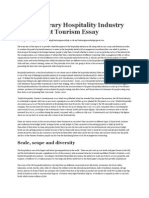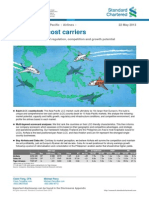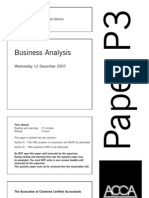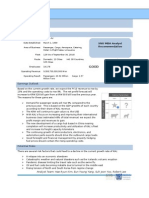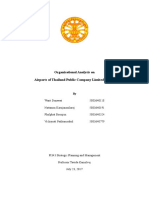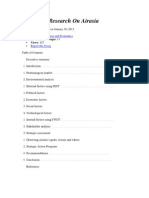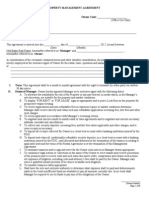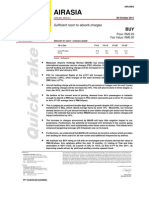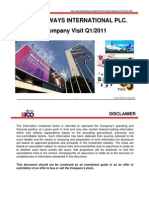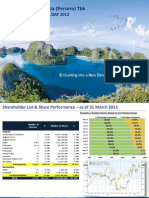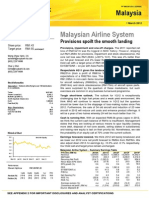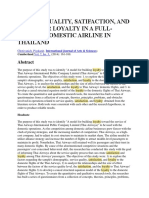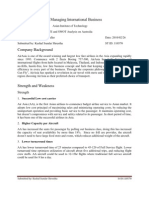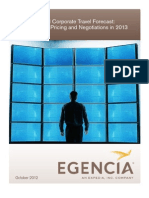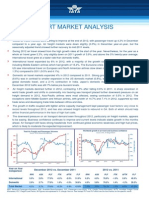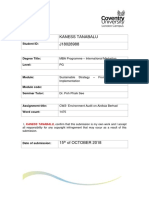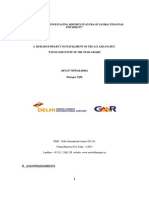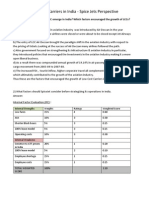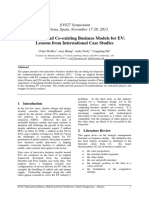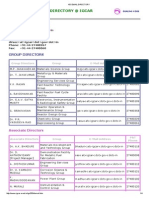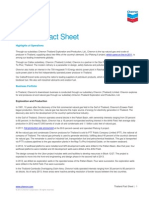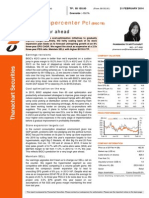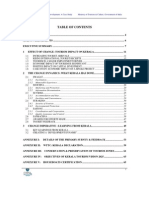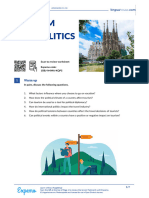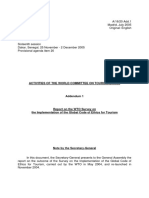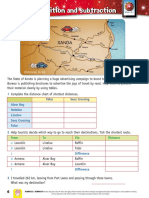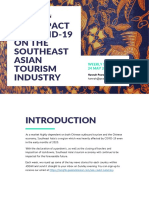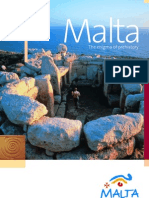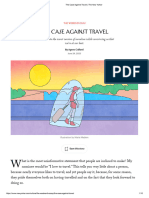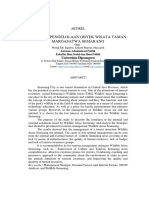Asia Aviation PCL: Jump On Board
Asia Aviation PCL: Jump On Board
Uploaded by
Vishan SharmaCopyright:
Available Formats
Asia Aviation PCL: Jump On Board
Asia Aviation PCL: Jump On Board
Uploaded by
Vishan SharmaOriginal Title
Copyright
Available Formats
Share this document
Did you find this document useful?
Is this content inappropriate?
Copyright:
Available Formats
Asia Aviation PCL: Jump On Board
Asia Aviation PCL: Jump On Board
Uploaded by
Vishan SharmaCopyright:
Available Formats
BUY
(Unchanged)
TP: Bt4.40
Upside: 30.2%
(From: Bt4.20)
4 JULY 2012
Change in Numbers
Asia Aviation Pcl
Jump on board
(AAV TB)
AAV will not only benefit from the low-cost airline boom but cost savings on its return to Don Mueang and a fall in jet fuel prices will help boost profits with forecast growth of 25% and 18% in 2012-13. Despite new aircraft deliveries speeding up, we like AAV as its one of the most cost-competitive airlines in the region.
SAKSID PHADTHANANARAK
662 617 4900 saksid.pha@thanachartsec.co.th
Thanachart Securities
Earnings lifted on Don Mueang return
We upgrade our earnings projections for AAV by 1.5% in 2012 and 6.1% in 2013-14 because of the benefits from the return to Don Mueang Airport. Thai AirAsia will move back from Suvarnabhumi Airport to Don Mueang on 1 October 2012. We estimate the total incentive amount from the discounts on landing and parking fees at Bt15m-55m during 2012-15 while we also expect Thai AirAsia to save Bt32m-188m a year on fuel costs given shorter taxiways at Don Mueang. They are also less crowded so Thai AirAsia wont have to waste so much fuel on waiting for take-off and landing. We lift our TP to Bt4.40 per share from Bt4.20 and we reiterate our BUY call.
COMPANY VALUATION
Y/E Dec (Bt m) Sales Net profit Consensus NP Diff from cons (%) Norm profit Prev norm profit Chg from prev (%) Norm EPS (Bt) 2011 8,123 1,014 2012F 20,895 1,175 1,341 (12.4) 1,275 1,254 1.6 0.3 24.7 11.9 3.7 4.3 2.1 67.3 (144.7) 2013F 25,274 1,626 1,670 (2.6) 1,626 1,532 6.1 0.3 17.8 10.1 3.7 3.3 3.0 37.1 (45.3) 2014F 30,155 1,851 2,097 (11.7) 1,851 1,744 6.1 0.4 13.9 8.9 2.6 2.6 3.4 32.8 (46.6)
936
0.2 13.3 14.8 16.1 na 0.0 na na
No doubts about passenger growth
Airports of Thailand (AOT) reported passenger growth for lowcost airlines of 16.2% y-y during January-May 2012. We believe this continued strong growth has been supported by: 1) Thailands popular tourist locations; 2) low-cost airlines lower fares allowing lower-income travelers to fly more frequently; and 3) a change in Thai peoples behavior to travel more by air due to greater flight frequency and more destinations. Given Thai AirAsias cabin factor of 82% in 1H12, our assumption of 80.4% in 2012 now looks easily achievable.
Norm EPS gr (%) Norm PE (x) EV/EBITDA (x) P/BV (x) Div. yield (%) ROE (%) Net D/E (%)
PRICE PERFORMANCE
(B t) 3.8 3.6 3.4 3.2 3.0 M ay-1 2 Jun-1 2 Jun-1 2 Jun-1 2 Jul-1 2 A sia A viatio n Rel to SET Index (%) 0 (5) (1 0) (1 5) (20)
Gain on asset revaluation
Given the low season, we estimate AAV will report normalized profits of Bt182m in 2Q12, down 42% q-q. However, two other extraordinary items will be booked in 2Q12. First, we expect AAV to book IPO fees of about Bt100m. Second, we also forecast it to book a gain on Thai AirAsias asset revaluation in 2Q12. The purchase of Thai AirAsias shares in June upped AAVs stake in Thai AirAsia to 55% from 51%. This will allow AAV to consolidate Thai AirAsias financial statements and revalue its assets. We expect the significant asset revaluation amount to be booked in AAVs consolidated net profits in 2Q12. Note that this is a non-cash item and we have yet to take into account this transaction.
COMPANY INFORMATION
Price as of 3-Jul-12 (Bt) Market cap (US$ m) Listed shares (m shares) Free float (%) Avg daily turnover (US$ m) 12M price H/L (Bt) Sector Major shareholder 3.38 523 4,850 25 22.76 4.0/3.0 Transportation AAV's management 60%
A chance to get into the stock
The fall in AAVs share price below the IPO level of Bt3.70 makes its valuation more attractive. We believe the shares should trade at a premium because of the firms cost competitiveness and Thailands low-cost airline boom but they are now at PE multiples of 11.9x and 10.1x in 2012F-13F versus peers 11.2x and 9.2x while also trading at the same EV/EBITDAR ratio as the industry average of 6.6x in 2012F.
Sources: Bloomberg, Company data, Thanachart estimates
This report is prepared by Thanachart Securities. Please contact our salesperson for authorisation. Please see the important notice on the back page
COMPANY NOTE
AAV
SAKSID PHADTHANANARAK
Earnings lifted on Don Mueang return
To solve the overcrowding problem at Suvarnabhumi Airport immediately, Airports of Thailands (AOT) board has approved the offering of incentives to those airlines that move back to Don Mueang Airport. The incentives are discounts on landing, parking and terminal servicing fees of up to 95% from 1 August 30 September 2012, 30% from 1 October 2012 30 September 2013, 20% from 1 October 2013 30 September 2014 and 10% from 1 October 2014 30 September 2015. Thai AirAsia will be the biggest beneficiary from this policy as its total number of domestic and international flights accounts for 49.5% of AOTs low-cost airline flights at Suvarnabhumi and Don Mueang airports.
Thai AirAsia is the biggest beneficiary of the return to Don Mueang as it dominates Thailands low-cost airline market
Ex 1: Thai AirAsia Dominates Thailands Low-Cost Airline Market Shares
Market Shares In January - May 2012 Thai AirAsia Nok Air Orient Thai Airlines Total Market Shares in January - May 2012 Thai AirAsia Malaysia AirAsia Tiger Airways JetStar Asia Indonesia AirAsia Jeju Air CEBU Pacific Air IndiGo Airlines Others Total
Source: Airports of Thailand
Domestic flights 49% 37% 13% 100% International flights 45% 16% 12% 7% 4% 3% 3% 3% 9% 100%
Domestic passengers 53% 35% 12% 100% International passengers 43% 15% 12% 7% 4% 3% 3% 3% 11% 100%
By moving to Don Mueang, Thai AirAsia will save 1. Bt15m-55m in landing and parking charges
Thai AirAsia is planning to move back from Suvarnabhumi to Don Mueang Airport on 1 October this year. The benefits from its Don Mueang return are estimated as follows: First, as the landing fee AOT collects on A320 aircraft is US$340 for international flights and US$170 for domestic flights, we conservatively project the total discount amount Thai AirAsia will get at Bt15.1m in 2012, Bt55.3m in 2013, Bt35.2m in 2014 and Bt15.1m in 2015 based on Thai AirAsias flight numbers during October 2010 September 2011. Second, Don Mueang Airports taxiways are shorter than those of Suvarnabhumi while it is also much less crowded so aircraft wont have to waste time and fuel waiting for take-off and landing, Thai AirAsia expects to save 1-2% on fuel expenses a year. We factor in cost savings on fuel expenses of 1.5% or Bt32m in 2012, Bt154m in 2013 and Bt188m in 2014. Third, we factor in AAVs relocation expenses of Bt60m in 2012. As a result, we revise up our normalized earnings projections by 1.5-6.1% in 2012-14. Our DCF-based TP with a WACC of 11.4% is upgraded to Bt4.40 a share from Bt4.20. We reiterate our BUY recommendation on AAV.
2. Bt32m-188m on fuel expenses
But it will involve relocation expenses of Bt60m Our TP is upgraded to Bt4.40 from Bt4.20
THANACHART RESEARCH
COMPANY NOTE
AAV
SAKSID PHADTHANANARAK
No doubts about passenger growth
Despite the European debt crisis, global air travel demand still grew above the trend rate
Despite the European debt crisis, global air travel demand has continued to expand strongly. Worldwide revenue passenger kilometers (RPK) grew by 7.1% y-y during January to April 2012, above the trend rate of 6%. The markets that showed strong growth were the Middle East, Latin America and Asia.
Ex 2: Global Demand For Travel And Cargo
Ex 3: Global Passenger Growth By Region
Jan-Apr 2012 y-y % Africa Asia Pacific Europe Latin America Middle East North America Total market RPK 8.5 8.4 6.7 9.8 19.0 2.3 7.1 ASK 7.5 6.7 3.5 10.3 13.3 0.5 4.9
Source: IATA
Source: IATA
Air travel demand in Thailand has showed even stronger growth
Air travel demand in Thailand has also shown a robust growth trend. AOTs total passenger numbers during January-May 2012 grew by 10.1% y-y while aircraft movements rose by 8.9% y-y. Passenger numbers from low-cost carriers during the same period showed even stronger growth of 16.2% y-y while low-cost airline flights increased by 14.3% y-y.
Ex 4: AOTs Passenger Numbers From Low-cost Carriers
('000 passengers) 6,000 5,000 4,000 3,000 2,000 1,000 0 4Q09 1Q10 2Q10 3Q10 4Q10 1Q11 2Q11 3Q11 4Q11 1Q12 Apr-May
Ex 5: AOTs Flight Numbers From Low-cost Carriers
(Flights) 45,000 40,000 35,000 30,000 25,000 20,000 15,000 10,000 5,000 0 4Q09 1Q10 2Q10 3Q10 4Q10 1Q11 2Q11 3Q11 4Q11 1Q12 Apr-May
3
Source: Airports of Thailand
Source: Airports of Thailand
THANACHART RESEARCH
COMPANY NOTE
AAV
SAKSID PHADTHANANARAK
We expect strong passenger growth to continue supported by the following reasons:
Despite Europes financial crisis, US and European passengers coming to Thailand still grew by 8.9% and 10.9%
The first and most important reason is Thailands attractions. It has various popular tourist destinations, warm weather, a reputation for hospitality and relatively low costs. Thailand has also developed much better travel infrastructure and accommodation than some of its neighbors making it more convenient for tourists. Surprisingly, despite Europes financial crisis, US and European passengers coming to Thailand during January-May 2012 still grew by 8.9% y-y and 10.9% y-y respectively.
Ex 6: Tourist Arrivals By Region
(m pax) Asia - Asean - North Asia - South Asia Oceania Europe Americas - US Middle East Africa Total
Source: Department of Tourism
2009 7.9 4.0 3.1 0.8 0.7 4.1 0.9 0.6 0.5 0.1 14.1
2010 9.2 4.5 3.6 1.0 0.8 4.4 0.8 0.6 0.6 0.1 15.9
2011 11.3 5.4 4.7 1.2 0.9 4.9 1.0 0.7 0.6 0.1 18.9
5M12 5.0 2.3 2.3 0.5 0.4 2.7 0.5 0.3 0.2 0.1 8.9
5M11 4.8 2.2 2.1 0.5 0.4 2.4 0.4 0.3 0.2 0.1 8.3
y-y % 5.1 0.9 9.5 5.6 10.1 10.9 10.9 8.9 (2.0) 30.5 7.3
Secondly, the emergence of low-cost airlines since 2003 has led to a substantial decrease in air fares, allowing the middle-income bracket in Thailand to fly. Finally, greater flight frequency and more destinations offered by low-cost airlines not only allow tourists to move easily around the country but, we believe, are also changing Thai peoples travel behavior, for example, from staying overnight on a sleeper train to spending three hours on a direct flight travelling from Chiang Mai to Phuket. Thai AirAsia reported a cabin factor of 87% in 1Q12 while the low tourism season caused its cabin factor to fall to 78% in 2Q12. Given a cabin factor of around 82% in 1H12, we now believe our cabin factor assumption of 80.4% for full-year 2012 is easily achievable.
Ex 7: AAVs Cabin Factor
(m RPK, m ASK) 18,000 16,000 14,000 12,000 10,000 8,000 6,000 4,000 2,000 2008 2009 2010 2011 2012F 2013F 2014F Revenue passenger kilometers (LHS) Available seat-kilometers (LHS) Cabin Factor (RHS) (%) 81 80 79 78 77 76 75 74 73
Given Thai AirAsias cabin factor of 82% in 1H12, our assumption of 80.4% for the full-year 2012 should be easily achievable
Sources: Company data, Thanachart estimates
THANACHART RESEARCH
COMPANY NOTE
AAV
SAKSID PHADTHANANARAK
Gain on asset revaluation
We expect AAV to report normalized earnings of Bt182m in 2Q12
Given a cabin factor of 78%, an average jet fuel price of US$122.5/bbl in 2Q12 and an increase in Thai AirAsias stake to 52.3% on average (from 51%) due to the share purchase in June, we forecast AAVs normalized earnings at Bt182m, falling 42% q-q. However, we expect AAV to book two extraordinary items this quarter. First, we expect AAV to book a one-time IPO fee of about Bt100m in 2Q12.
But AAV should also book a significant gain on Thai AirAsias asset revaluation
Second, after listing on the SET, AAV has increased its stake in Thai AirAsia to 55% from 51% in June 2012. This will allow AAV to consolidate Thai AirAsias financial statements and revalue Thai AirAsias assets. We expect the significant asset revaluation amount to be booked in AAVs consolidated net profits in 2Q12. Please note that we have yet to take into account this transaction but it will not have a significant impact on our DCF-based TP as it is a non-cash item. Given the peak tourism season in 4Q12 and the falling jet fuel price trend in 2H12, we still believe our normalized earnings forecast of Bt1.3bn for full-year 2012 is within reach.
Ex 8: Jet Fuel Prices
(US$/bbl) 150 140 130 120 110 100 90 80 70 May-10 May-11 May-12 Mar-10 Mar-11 Nov-10 Nov-11 Sep-10 Sep-11 Mar-12 Jan-10 Jan-11 Jan-12 Jul-10 Jul-11
Ex 9: Our Earnings Forecasts For AAV
(Bt m) 2,000 1,600 1,200 800 400 0 (400) 2009 2010 2011 2012F 2013F 2014F
Source: Datastream
Sources: Company data, Thanachart estimates
Ex 10: Key Assumptions
2011 Load factor (%) Passenger yield (Bt/passenger/kilometer) Ancillary income per passenger (Bt/passenger) Jet fuel price (US$/bbl) Exchange rate (Bt/US dollar) Total passengers carried (passengers)
Sources: Company data, Thanachart estimates
2012F 80.4 1.79 390 119 31.4 8.2
2013F 78.7 1.82 400 113 32.0 9.4
80.3 1.76 382 124 30.5 6.9
THANACHART RESEARCH
COMPANY NOTE
AAV
SAKSID PHADTHANANARAK
A chance to get into the stock
We like AAV because of its cost competitiveness
Despite new aircraft deliveries speeding up and severe competition, we still like AAV because of its cost competitiveness. Efficient management in high-seating-density, highutilization and no-frills aircraft with basic ground services make Thai AirAsias operating costs not only lower than full-service airlines but also those of low-cost peers.
Ex 11: Thai AirAsias Competitive CASK
(US$ cents/ASK) 7 6 5 4 3 2 1 0 EasyJet GOL Southwest Air Arabia Indonesia AirAsia Tiger Airways Malaysia AirAsia Indigo SpiceJet WestJet RyanAir Cebu Pacific Thai AirAisa
Sources: Air Arabia Presentation 2011, AirAsia Presentation 4Q11, Tiger Airways Presentation end-December 2011, Cebu Pacific Presentation March 2012, The S-A-P Group January 2012
The recent fall in AAVs share price below its IPO level of Bt3.70 looks unjustified; BUY
Given its cost competitiveness and Thailands low-cost airline boom, we believe AAVs shares deserve to trade at a premium to its peers. Thus, the recent fall in AAVs share price below its IPO level of Bt3.70 appears unjustified. Moreover, the shares are now trading at the same level as its peers despite offering a higher return on equity (ROE). The counter is on PE multiples of 11.9x and 10.1x in 2012F-13F versus its peers PE of 11.2x and 9.2x while also trading at the same EV/EBITDAR multiple as the industry average of 6.6x in 2012F.
THANACHART RESEARCH
COMPANY NOTE
AAV
SAKSID PHADTHANANARAK
Valuation Comparison
Ex 12: Valuation Comparison With Regional Peers
EPS Growth PE Company Code Country 12F (%) Virgin Australia Holdings Ryanair Holdings PLC AirAsia BHD VAH AU RYA ID AIRA MK Australia Ireland Malaysia Norway Philippines na 27.0 17.0 191.1 14.4 1.7 6.8 13F (%) 80.8 (0.3) 19.3 28.4 15.8 19.7 12.0 12F (x) 14.4 12.2 11.4 9.1 10.6 9.7 10.6 13F (x) 8.0 12.2 9.5 7.1 9.1 8.1 P/BV 12F (x) 0.9 1.7 2.0 1.7 1.8 0.5 13F (x) 0.8 1.7 1.7 1.3 1.5 0.5 Div. Yield 12F (%) 0.0 0.5 0.8 0.0 2.5 8.4 0.0 13F (%) 1.9 4.6 0.9 na 2.9 9.8 0.0 ROE 12F (%) 5.3 15.1 19.4 19.3 18.5 5.6 11.9 13F (%) 9.4 14.2 19.0 20.0 18.8 6.8 12.5 EV/EBITDAR 12F (x) 5.7 6.4 8.3 7.0 6.7 6.7 5.6 13F (x) 5.0 6.4 7.4 5.3 5.7 5.5 5.1
Norwegian Air Shuttle AS NAS NO Cebu Air Inc Air Arabia PJSC EasyJet PLC CEB PM
AIRARABI UH UAE EZJ LN UK
9.5 126.2 113.1
Asia Aviation Average
Source: Bloomberg
AAV TB*
Thailand
24.7 43.0
18.0 25.1
11.9 11.1
10.1 9.1
4.3 19.3
3.3 17.2
2.1 1.7
3.0 3.4
67.3 13.6
37.1 14.4
6.6 6.6
6.7 5.8
Note: * Thanachart estimates using Normalized EPS
THANACHART RESEARCH
APPENDIX
AAV
SAKSID PHADTHANANARAK
COMPANY DESCRIPTION
Asia Aviation is the major shareholder in Thai AirAsia, the leading low-cost carrier based in Thailand. Thai AirAsia is one of the lowestcost carriers in Asia. The carrier dominates the low-cost airline market in Thailand with a share of 45%. The company currently operates 24 Airbus A320s with an average fleet age of two years and four months from three hubs in Thailand: Suvarnabhumi, Phuket and Chiang Mai airports. Its service areas are in Southeast Asia with less-than-fourhour flights from its hubs.
COMPANY RATING
F ina nc ia l m a na ge m e nt
Rating Scale Very Strong
R is k m a na ge m e nt
M a na ge m e nt
5 4 3 2 1 0
5 4 3 2 1 0
Strong Good Fair
Liquidit y
*C o rp. go v e rna nc e
Weak None
Source: Thanachart
Source: Thanachart; *CG Awards, no rating
THANACHARTS SWOT ANALYSIS S Strength It is one of the lowest-cost carriers in Asia. Being a member of AirAsia group allows it to benefit from bargaining power, cross-selling opportunities and scale. Its ancillary income strategy protects against the risk of making losses. O Opportunity Asia is one of the fastest-growing low-cost airline markets. Thailand is one of the top destinations for tourists. Its service areas cover some parts of China and India, the No.1 and No.2 countries by population. W Weakness All aircraft are leased, causing high maintenance
expenses. Limited service areas with a four-hour flight maximum. Asia Aviation is a holding company, so it is highly dependent on Thai AirAsias dividend payment. T Threat Highly volatile jet fuel prices pose a major risk. Competition in the aviation industry is fierce while demand for travel is also dependant on global economic situations. Other transportation methods such as high-speed trains are being developed.
CONSENSUS COMPARISON
Consensus Target price (Bt) Net profit 12F (Bt m) Net profit 13F (Bt m) Consensus REC 3.84 1,341 1,670 BUY: 2 Thanachart 4.40 1,175 1,626 HOLD: 1 Diff 15% -12% -3% SELL: 0
RISKS TO OUR INVESTMENT CASE
Fuel expenses account for almost 50% of Thai AirAsias total costs. Therefore, fluctuations in jet fuel prices are a major risk to our earnings projections. Political unrest and natural disasters in Thailand are another worry as they would have a significant impact upon the tourism industry. Congestion at airports in Thailand could make the carriers turnaround times slower, causing it to be less efficient. Uncertainty over the Thai governments airport policy in Bangkok represents a risk to the carriers operations.
HOW ARE WE DIFFERENT FROM THE STREET?
Our earnings forecasts in 2012F-13F are below the consensus as we apply more conservative cabin factor assumptions. However, our TP is higher than the Streets due to our more positive outlook on the company over the longer term.
Sources: Bloomberg consensus, Thanachart estimates
Source: Thanachart
THANACHART RESEARCH
FINANCIAL SUMMARY
AAV
SAKSID PHADTHANANARAK
INCOME STATEMENT
FY ending Dec 2010A 6,049 4,983 1,067 17.6% 300 767 12.7% 59 826 13.7% 182 0 (122) 827 0 827 13.7% 0 0 178 1,005 827 0.2 0.2 2011A 8,123 6,915 1,208 14.9% 406 802 9.9% 34 836 10.3% 226 0 (92) 936 0 936 11.5% 0 0 78 1,014 936 0.2 0.2 2012F 20,895 17,204 3,691 17.7% 1,358 2,333 11.2% 194 2,526 12.1% 516 0 (19) 2,830 424 2,405 11.5% 0 (1,130) (100) 1,175 1,275 0.3 0.3 2013F 25,274 20,889 4,385 17.4% 1,441 2,945 11.7% 561 3,506 13.9% 540 0 (48) 3,437 481 2,956 11.7% 0 (1,330) 0 1,626 1,626 0.3 0.3 2014F 30,155 25,034 5,121 17.0% 1,659 3,462 11.5% 984 4,446 14.7% 522 0 (70) 3,913 548 3,366 11.2% 0 (1,515) 0 1,851 1,851 0.4 0.4
We forecast the boom in low-cost airlines with a fall in jet fuel prices to boost AAVs earnings by 25% this year and 18% next year
Sales Cost of sales Gross profit % gross margin Selling & administration expenses Operating profit % operating margin Depreciation & amortization EBITDA % EBITDA margin Non-operating income Non-operating expenses Interest expense Pre-tax profit Income tax After-tax profit % net margin Shares in affiliates' Earnings Minority interests Extraordinary items NET PROFIT Normalized profit EPS (Bt) Normalized EPS (Bt)
BALANCE SHEET
FY ending Dec (Bt m) ASSETS: Current assets: Cash & cash equivalent Account receivables Inventories Others Investments & loans Net fixed assets Other assets Total assets LIABILITIES: Current liabilities: Account payables Bank overdraft & ST loans Current LT debt Others current liabilities Total LT debt Others LT liabilities Total liabilities Minority interest Preferreds shares Paid-up capital Share premium Warrants Surplus Retained earnings Shareholders' equity Liabilities & equity
Sources: Company data, Thanachart estimates
2010A 2,035 260 55 3 1,717 4 137 549 2,726
2011A 1,451 694 98 26 633 4 154 614 2,224
2012F 9,632 7,700 252 65 1,615 4 2,961 1,581 14,177
2013F 7,237 4,900 304 79 1,954 4 8,100 1,912 17,252
2014F 9,189 6,400 363 95 2,331 4 11,616 2,281 23,089
AAV is a net cash company due to all its aircraft being leased
3,685 111 101 0 3,473 1 0 3,685 0 0 410 0 0 0 (1,369) (959) 2,726
2,162 88 2 248 1,824 11 42 2,216 0 0 410 0 0 (16) (387) 8 2,224
9,131 219 6 563 8,343 26 109 9,266 1,130 0 485 2,700 0 (16) 612 3,781 14,177
9,607 265 14 1,444 7,883 67 131 9,805 2,460 0 485 2,700 0 (16) 1,817 4,987 17,252
12,571 318 15 1,515 10,723 70 157 12,798 3,975 0 485 2,700 0 (16) 3,147 6,316 23,089
THANACHART RESEARCH
FINANCIAL SUMMARY
AAV
SAKSID PHADTHANANARAK
CASH FLOW STATEMENT
FY ending Dec (Bt m) 2010A 827 0 59 (102) (973) (189) (53) (53) 0 0 (58) (163) 279 0 0 0 279 (242) 2011A 936 0 34 (89) (617) 264 (51) 52 0 0 (23) (21) 238 0 0 (47) 191 213 2012F 2,830 (424) 194 (62) 5,532 8,069 (3,000) 5 0 0 (1,000) (3,995) 333 2,775 (176) 0 2,932 5,069 2013F 3,437 (481) 561 (20) (798) 2,699 (5,700) 0 0 0 (308) (6,008) 930 0 (420) 0 509 (3,001) 2014F 3,913 (548) 984 (22) 2,462 6,790 (4,500) 0 0 0 (344) (4,844) 75 0 (522) 0 (446) 2,290 Earnings before tax Tax paid Depreciation & amortization Chg In working capital Chg In other CA & CL / minorities Cash flow from operations Capex ST loans & investments LT loans & investments Adj for asset revaluation Chg In other assets & liabilities Cash flow from investments Debt financing Capital increase Dividends paid Warrants & other surplus Cash flow from financing Free cash flow
We expect AAV to buy two aircraft this year and four next year
VALUATION
FY ending Dec Normalized PE (x) Normalized PE - at target price (x) PE (x) PE - at target price (x) EV/EBITDA (x) EV/EBITDA - at target price (x) P/BV (x) 2010A 16.8 21.8 13.8 18.0 16.6 21.6 na na (73.2) 2.7 0.0 (1.7) 2011A 14.8 19.3 13.7 17.8 16.1 21.1 na na 52.6 2.0 0.0 1.5 2012F 11.9 15.5 12.9 16.8 3.7 5.6 4.3 5.6 1.9 0.8 2.1 33.5 2013F 10.1 13.1 10.1 13.1 3.7 5.1 3.3 4.3 6.1 0.6 3.0 (18.3) 2014F 8.9 11.5 8.9 11.5 2.6 3.7 2.6 3.4 2.4 0.5 3.4 14.0
Shares now trade at PE multiples of 11.9x in 2012F versus peers 11.2x despite AAVs cost competitiveness and Thailands low-cost airline boom
P/BV - at target price (x) P/CFO (x) Price/sales (x) Dividend yield (%) FCF Yield (%) (Bt) Normalized EPS EPS DPS BV/share CFO/share FCF/share
Sources: Company data, Thanachart estimates
0.2 0.2 0.0 (0.2) (0.0) (0.1)
0.2 0.2 0.0 0.0 0.1 0.1
0.3 0.3 0.1 0.8 1.8 1.1
0.3 0.3 0.1 1.0 0.6 (0.6)
0.4 0.4 0.1 1.3 1.4 0.5
THANACHART RESEARCH
10
FINANCIAL SUMMARY
AAV
SAKSID PHADTHANANARAK
FINANCIAL RATIOS
FY ending Dec Growth Rate Sales (%) Net profit (%) EPS (%) Normalized profit (%) Normalized EPS (%) Dividend payout ratio (%) Operating performance Gross margin (%) Operating margin (%) EBITDA margin (%) Net margin (%) D/E (incl. minor) (x) Net D/E (incl. minor) (x) Interest coverage - EBIT (x) Interest coverage - EBITDA (x) ROA - using norm profit (%) ROE - using norm profit (%) DuPont ROE - using after tax profit (%) - asset turnover (x) - operating margin (%) - leverage (x) - interest burden (%) - tax burden (%) WACC (%) ROIC (%) NOPAT (Bt m)
Sources: Company data, Thanachart estimates
2010A 30.4 na na na na 0.0
2011A 34.3 0.9 0.9 13.3 13.3 0.0
2012F 157.2 15.8 6.0 36.2 24.7 30.0
2013F 21.0 38.4 27.8 27.5 17.8 30.0
2014F 19.3 13.9 13.9 13.9 13.9 30.0
17.6 12.7 13.7 13.7 (0.1) 0.2 6.3 6.8 40.8 na
14.9 9.9 10.3 11.5 34.2 (56.6) 8.7 9.1 37.8 na
17.7 11.2 12.1 11.5 0.1 (1.4) 121.0 131.1 15.5 67.3
17.4 11.7 13.9 11.7 0.2 (0.5) 61.7 73.5 10.3 37.1
17.0 11.5 14.7 11.2 0.2 (0.5) 49.3 63.2 9.2 32.8
na 3.0 15.7 (1.4) 87.2 100.0 11.4 (33.4) 767
na 3.3 12.7 (5.2) 91.1 100.0 11.4 (71.7) 802
127.0 2.5 13.6 4.3 99.3 85.0 11.4 (466.5) 1,983
67.4 1.6 13.8 3.6 98.6 86.0 11.4 (76.2) 2,533
59.6 1.5 13.2 3.6 98.2 86.0 11.4 184.8 2,977
THANACHART RESEARCH
11
DISCLAIMER
AAV
SAKSID PHADTHANANARAK
General Disclaimers And Disclosures: This report is prepared and issued by Thanachart Securities Public Company Limited (TNS) as a resource only for clients of TNS, Thanachart Capital Public Company Limited (TCAP) and its group companies. Copyright Thanachart Securities Public Company Limited. All rights reserved. The report may not be reproduced in whole or in part or delivered to other persons without our written consent.
This report is prepared by analysts who are employed by the research department of TNS. While the information is from sources believed to be reliable, neither the information nor the forecasts shall be taken as a representation or warranty for which TNS or TCAP or its group companies or any of their employees incur any responsibility. This report is provided to you for informational purposes only and it is not, and is not to be construed as, an offer or an invitation to make an offer to sell or buy any securities. Neither TNS, TCAP nor its group companies accept any liability whatsoever for any direct or consequential loss arising from any use of this report or its contents.
The information and opinions contained herein have been compiled or arrived at from sources believed reliable. However, TNS, TCAP and its group companies make no representation or warranty, express or implied, as to their accuracy or completeness. Expressions of opinion herein are subject to change without notice. The use of any information, forecasts and opinions contained in this report shall be at the sole discretion and risk of the user.
TNS, TCAP and its group companies perform and seek to perform business with companies covered in this report. TNS, TCAP, its group companies, their employees and directors may have positions and financial interest in securities mentioned in this report. TNS, TCAP or its group companies may from time to time perform investment banking or other services for, or solicit investment banking or other business from, any entity mentioned in this report. Therefore, investors should be aware of conflict of interest that may affect the objectivity of this report.
THANACHART RESEARCH
12
DISCLAIMER
AAV
SAKSID PHADTHANANARAK
Recommendation Structure:
Recommendations are based on absolute upside or downside, which is the difference between the target price and the current market price. If the upside is 10% or more, the recommendation is BUY. If the downside is 10% or more, the recommendation is SELL. For stocks where the upside or downside is less than 10%, the recommendation is HOLD. Unless otherwise specified, these recommendations are set with a 12-month horizon. Thus, it is possible that future price volatility may cause a temporary mismatch between upside/downside for a stock based on the market price and the formal recommendation.
For sectors, we look at two areas, ie, the sector outlook and the sector weighting. For the sector outlook, an arrow pointing up, or the word Positive, is used when we see the industry trend improving. An arrow pointing down, or the word Negative, is used when we see the industry trend deteriorating. A double-tipped horizontal arrow, or the word Unchanged, is used when the industry trend does not look as if it will alter. The industry trend view is our top-down perspective on the industry rather than a bottom-up interpretation from the stocks we cover. An Overweight sector weighting is used when we have BUYs on majority of the stocks under our coverage by market cap. Underweight is used when we have SELLs on majority of the stocks we cover by market cap. Neutral is used when there are relatively equal weightings of BUYs and SELLs.
Thanachart Securities Pcl.
Research Team 28 Floor, Siam Tower Unit A1 989 Rama 1, Pathumwan Road, Bangkok 10330 Tel: 662 - 617 4900
Pimpaka Nichgaroon, CFA Head of Research Economics & Strategy pimpaka.nic@thanachartsec.co.th Sarachada Sornsong Banks, Telecom sarachada.sor@thanachartsec.co.th Phannarai Tiyapittayarut Property, Retail phannarai.von@thanachartsec.co.th Saksid Phadthananarak Electronics, Construction, Transportation saksid.pha@thanachartsec.co.th Kalvalee Thongsomaung Food, Media, Hotel kalvalee.tho@thanachartsec.co.th Noppadol Pririyawut Senior Technical Analyst noppadol.pri@thanachartsec.co.th Adisak Phupiphathirungul, CFA Retail Market Strategy adisak.phu@thanachartsec.co.th Supanna Suwankird Energy, Utilities supanna.suw@thanachartsec.co.th Siriporn Arunothai Ad Hoc Research, Healthcare siriporn.aru@thanachartsec.co.th
THANACHART RESEARCH
13
You might also like
- Tiger Airways Report - FinalDocument30 pagesTiger Airways Report - Finalanon_55543583988% (8)
- Sell Side M&aDocument21 pagesSell Side M&aVishan Sharma100% (1)
- Contemporary Hospitality Industry Assignment Tourism EssayDocument4 pagesContemporary Hospitality Industry Assignment Tourism EssayHND Assignment Help100% (1)
- Asia's Low-Cost Carriers A Comprehensive Study of Regulation, Competition and Growth Potential 21-05-13!18!30Document131 pagesAsia's Low-Cost Carriers A Comprehensive Study of Regulation, Competition and Growth Potential 21-05-13!18!30m76507084No ratings yet
- Business Analysis AssignmentDocument9 pagesBusiness Analysis AssignmentAlim ChanaNo ratings yet
- Korean Air Project FinalDocument24 pagesKorean Air Project FinalRobert LeeNo ratings yet
- Organisational Analysis On AOTDocument33 pagesOrganisational Analysis On AOTAlcaNo ratings yet
- Marketing Research On AirasiaDocument9 pagesMarketing Research On AirasiaLiew WaiyanNo ratings yet
- Air Asia StrategyDocument15 pagesAir Asia StrategyHenry Teepoh25% (4)
- Airline Industry ProfileDocument42 pagesAirline Industry Profilepantmukul0% (1)
- Management AgreementDocument6 pagesManagement AgreementVishan SharmaNo ratings yet
- AirAsia 111028Document2 pagesAirAsia 111028Adrian LimNo ratings yet
- Msia Aviation SU 050413 2045Document21 pagesMsia Aviation SU 050413 2045JcoveNo ratings yet
- Bagianku CH 3Document6 pagesBagianku CH 3Cynthia AdiantiNo ratings yet
- Current Assets Current LiabilitiesDocument6 pagesCurrent Assets Current LiabilitiesToo YunHangNo ratings yet
- Air Asia CompleteDocument18 pagesAir Asia CompleteAmy CharmaineNo ratings yet
- Company Visit Q1 11 ThaiDocument49 pagesCompany Visit Q1 11 ThaiMeghna GuptaNo ratings yet
- Investor Day-Final Draft For WEBDocument40 pagesInvestor Day-Final Draft For WEBElisabet GebiNo ratings yet
- PWC Tailwinds Airline Industry Trends Issue 1Document12 pagesPWC Tailwinds Airline Industry Trends Issue 1getoboyNo ratings yet
- Industry Forecast MRO PDFDocument29 pagesIndustry Forecast MRO PDFtwj84100% (2)
- Malaysian Airline System Provisions Spoilt The Smooth LandingDocument7 pagesMalaysian Airline System Provisions Spoilt The Smooth LandingJeremy SeeNo ratings yet
- Chien Luoc ANADocument5 pagesChien Luoc ANALe XuanNo ratings yet
- Service Quality, Satifaction, and Customer Loyalty in A Full-Service Domestic Airline in ThailandDocument22 pagesService Quality, Satifaction, and Customer Loyalty in A Full-Service Domestic Airline in ThailandRiefky AriefiantoNo ratings yet
- Pia Report by Sadia Sir MuzamilDocument27 pagesPia Report by Sadia Sir MuzamilSADIA RIZWAN BAIGNo ratings yet
- Air AsiaDocument22 pagesAir AsiaMohd Mazhan Kaya Amin50% (2)
- Industry Outlook Presentation March2012 PDFDocument18 pagesIndustry Outlook Presentation March2012 PDFabhinavchawhanNo ratings yet
- Strength and Weakness FDI and ConclusionDocument5 pagesStrength and Weakness FDI and ConclusionKushal Sundar ShresthaNo ratings yet
- Business Strategy December 2011 Exam PaperDocument10 pagesBusiness Strategy December 2011 Exam PaperTAPKNo ratings yet
- 09 Southwest AirDocument13 pages09 Southwest AirmskrierNo ratings yet
- 2 22561 Egencia 2013 Global Travel Forecast USDocument10 pages2 22561 Egencia 2013 Global Travel Forecast USAt YugovicNo ratings yet
- AVB Porter's 5 Forces PT Air Asia IndonesiaDocument24 pagesAVB Porter's 5 Forces PT Air Asia IndonesiaVidya Intani100% (1)
- MIS Note Dec12Document7 pagesMIS Note Dec12ArunkumarNo ratings yet
- Easyjet ThesisDocument5 pagesEasyjet ThesisStacy Taylor100% (2)
- Frost and Sulivan IAMSA PresentationDocument27 pagesFrost and Sulivan IAMSA PresentationAgusNuraminNo ratings yet
- PiaDocument50 pagesPiaVicky ChouhanNo ratings yet
- Mithilesh Trivedi Batch: - PGP/SS/13-15/T2Document53 pagesMithilesh Trivedi Batch: - PGP/SS/13-15/T2RaviGajjarNo ratings yet
- Group Assignment: Subject: Financial Report AnalysisDocument21 pagesGroup Assignment: Subject: Financial Report Analysisk21clca1 hvnhNo ratings yet
- Financial Analysis of Tiger Airways 2012Document11 pagesFinancial Analysis of Tiger Airways 2012Felix LuNo ratings yet
- Kaness Tanabalu J18028988: Student Name: Student IDDocument24 pagesKaness Tanabalu J18028988: Student Name: Student IDKaness TanabaluNo ratings yet
- The Low Budget Airline Jetstar Asia Airways Tourism EssayDocument10 pagesThe Low Budget Airline Jetstar Asia Airways Tourism EssayudanasrNo ratings yet
- Aviation - Jun10Document6 pagesAviation - Jun10nitin2khNo ratings yet
- ACI Project May, 09Document14 pagesACI Project May, 09aryan295No ratings yet
- Boeing Current Market Outlook 2014 PresentationDocument33 pagesBoeing Current Market Outlook 2014 PresentationAman VermaNo ratings yet
- Jakarta Airport Advertising. Jakarta Airport Ad AgencyDocument22 pagesJakarta Airport Advertising. Jakarta Airport Ad AgencySovereignAdNo ratings yet
- JetLite PDFDocument27 pagesJetLite PDFAnirudha GoraiNo ratings yet
- Spice JetDocument4 pagesSpice JetPratik JagtapNo ratings yet
- Final PPT 4 April JetBlueDocument43 pagesFinal PPT 4 April JetBlueNii Ben100% (1)
- Autos MalaysiaDocument45 pagesAutos MalaysiaNicholas AngNo ratings yet
- SWOTDocument3 pagesSWOTĐạt PhạmNo ratings yet
- RyanairDocument7 pagesRyanairJoão CaladoNo ratings yet
- Economic Analysis Project - VuHueDocument8 pagesEconomic Analysis Project - VuHueHana VũNo ratings yet
- Strategic Management ProjectDocument34 pagesStrategic Management ProjecthetalodedraNo ratings yet
- Malaysian Airlines Presented By: Strategic ManagementDocument10 pagesMalaysian Airlines Presented By: Strategic ManagementAkmal Gondal100% (2)
- Analysis of AirAsia, Malaysian Airlines and Singapore AirlinesDocument39 pagesAnalysis of AirAsia, Malaysian Airlines and Singapore AirlinesZia100% (12)
- Echartbook Q21 2013 PDFDocument7 pagesEchartbook Q21 2013 PDF15221122069No ratings yet
- 293.HK 2013 Annual-Report ZHDocument52 pages293.HK 2013 Annual-Report ZHoscarNo ratings yet
- Review and Assessment of the Indonesia–Malaysia–Thailand Growth Triangle Economic Corridors: Indonesia Country ReportFrom EverandReview and Assessment of the Indonesia–Malaysia–Thailand Growth Triangle Economic Corridors: Indonesia Country ReportNo ratings yet
- Air Brakes (C.V. OE & Aftermarket) World Summary: Market Values & Financials by CountryFrom EverandAir Brakes (C.V. OE & Aftermarket) World Summary: Market Values & Financials by CountryNo ratings yet
- Financial Soundness Indicators for Financial Sector Stability in Viet NamFrom EverandFinancial Soundness Indicators for Financial Sector Stability in Viet NamNo ratings yet
- Review and Assessment of the Indonesia–Malaysia–Thailand Growth Triangle Economic Corridors: Integrative ReportFrom EverandReview and Assessment of the Indonesia–Malaysia–Thailand Growth Triangle Economic Corridors: Integrative ReportNo ratings yet
- Asian Economic Integration Report 2018: Toward Optimal Provision of Regional Public Goods in Asia and the PacificFrom EverandAsian Economic Integration Report 2018: Toward Optimal Provision of Regional Public Goods in Asia and the PacificNo ratings yet
- Review and Assessment of the Indonesia–Malaysia–Thailand Growth Triangle Economic Corridors: Malaysia Country ReportFrom EverandReview and Assessment of the Indonesia–Malaysia–Thailand Growth Triangle Economic Corridors: Malaysia Country ReportNo ratings yet
- Competing and Co-Existing Business Models For EV: Lessons From International Case StudiesDocument12 pagesCompeting and Co-Existing Business Models For EV: Lessons From International Case StudiesVishan SharmaNo ratings yet
- Igcemail DirectoryDocument4 pagesIgcemail DirectoryVishan SharmaNo ratings yet
- John Woodhouse - AM Planning & Roadmap PDFDocument24 pagesJohn Woodhouse - AM Planning & Roadmap PDFVishan SharmaNo ratings yet
- Frontier Market BondsDocument1 pageFrontier Market BondsVishan SharmaNo ratings yet
- Chevron Thailand FactsheetDocument5 pagesChevron Thailand FactsheetVishan SharmaNo ratings yet
- Myanmar MSWDocument4 pagesMyanmar MSWVishan SharmaNo ratings yet
- Business Opportunities in The Emerging Lubricant Markets of South Asia, The Middle East, and Northern Africa, 2005-2015Document11 pagesBusiness Opportunities in The Emerging Lubricant Markets of South Asia, The Middle East, and Northern Africa, 2005-2015Vishan SharmaNo ratings yet
- Big C Supercenter: Tough Year AheadDocument10 pagesBig C Supercenter: Tough Year AheadVishan SharmaNo ratings yet
- Banpu Analytical Disclosure Workshop Jun 2012Document45 pagesBanpu Analytical Disclosure Workshop Jun 2012Vishan SharmaNo ratings yet
- Thailand'S: Top Local KnowledgeDocument8 pagesThailand'S: Top Local KnowledgeVishan SharmaNo ratings yet
- Siam Senses: Revisiting Thai PositionsDocument16 pagesSiam Senses: Revisiting Thai PositionsVishan SharmaNo ratings yet
- Thailand'S: Top Local KnowledgeDocument9 pagesThailand'S: Top Local KnowledgeVishan SharmaNo ratings yet
- Convert Rai To Square Meters in Thailand - Convert Rai, Hectare, Wah - LandDocument2 pagesConvert Rai To Square Meters in Thailand - Convert Rai, Hectare, Wah - LandVishan SharmaNo ratings yet
- Tirathai Public Company Limited: Opportunity Day On 23 May 2013Document26 pagesTirathai Public Company Limited: Opportunity Day On 23 May 2013Vishan SharmaNo ratings yet
- Thailand: Bangkok LandDocument15 pagesThailand: Bangkok LandVishan SharmaNo ratings yet
- Sansiri: Growing Property Development With A Compound Annual Growth Rate of 18%Document6 pagesSansiri: Growing Property Development With A Compound Annual Growth Rate of 18%Vishan SharmaNo ratings yet
- Jasmine International PCL: Very Strong Growth MomentumDocument11 pagesJasmine International PCL: Very Strong Growth MomentumVishan SharmaNo ratings yet
- Cabin Pressure Series 1, Episode 3 - CremonaDocument19 pagesCabin Pressure Series 1, Episode 3 - CremonaalolapukaNo ratings yet
- Kerala's Approach To Tourism Development: A Case Study Ministry of Tourism & Culture, Government of IndiaDocument70 pagesKerala's Approach To Tourism Development: A Case Study Ministry of Tourism & Culture, Government of Indiahsood100% (1)
- Tourism and Politics American English TeacherDocument10 pagesTourism and Politics American English Teacherryan vitorianoNo ratings yet
- Subject: Oral Communication in Context Week: 7 (4 Hours) Lesson: Communicative Competence Strategies in Various Speech Situations Content StandardDocument5 pagesSubject: Oral Communication in Context Week: 7 (4 Hours) Lesson: Communicative Competence Strategies in Various Speech Situations Content StandardMaria Ana Patron100% (1)
- 08 Chapter 02 PDFDocument42 pages08 Chapter 02 PDFkumara deepanNo ratings yet
- d1 2nycDocument8 pagesd1 2nycapi-355667111No ratings yet
- Activities of The World Committee On Tourism EthicsDocument33 pagesActivities of The World Committee On Tourism EthicsManjeet Kour BaliNo ratings yet
- 04 Handout 1Document12 pages04 Handout 1Mr. NicksNo ratings yet
- Kenya Tanzanya Travel Agent ListDocument5 pagesKenya Tanzanya Travel Agent ListGanesh Mali100% (1)
- Ac TM SB Year 6 pp06-08 Fillable Saveable-2Document3 pagesAc TM SB Year 6 pp06-08 Fillable Saveable-2api-394727402No ratings yet
- Hotel and Motel in DhakaDocument1 pageHotel and Motel in DhakaNiloy Ahmed100% (1)
- Covid 19 - SeaDocument70 pagesCovid 19 - SeaBaty NeNo ratings yet
- Malta: The Enigma of PrehistoryDocument8 pagesMalta: The Enigma of PrehistoryVisitMaltaNo ratings yet
- The Case Against Travel - The New YorkerDocument10 pagesThe Case Against Travel - The New Yorkeralvarado.sarae12No ratings yet
- Kashmir Pen Issue 5 Vol 9Document16 pagesKashmir Pen Issue 5 Vol 9Rouf Ahmed NajarNo ratings yet
- Kiyomizu DeraDocument4 pagesKiyomizu Deraavonpersu001No ratings yet
- Mini Test Unit 5 G9Document2 pagesMini Test Unit 5 G9Tui Là BùiNo ratings yet
- G.R. No. 211293, June 04, 2019 Doctrine:: Oriondo vs. COADocument1 pageG.R. No. 211293, June 04, 2019 Doctrine:: Oriondo vs. COAstephanie linajaNo ratings yet
- Airbnb Travel Trends Report - 16 Neighborhoods To Discover in 2016 - 1.6.16Document22 pagesAirbnb Travel Trends Report - 16 Neighborhoods To Discover in 2016 - 1.6.16dimitriou1973100% (1)
- Chapter 1Document23 pagesChapter 1Gva UmayamNo ratings yet
- W Hospitality Group Hotel Chain Development Pipelines in Africa 2018 2Document56 pagesW Hospitality Group Hotel Chain Development Pipelines in Africa 2018 2Evah Boemo MosetlhaneNo ratings yet
- Speaking Test (All 3 Parts)Document4 pagesSpeaking Test (All 3 Parts)hanvh.gdcNo ratings yet
- Unit 2Document2 pagesUnit 2nguyen nguyenNo ratings yet
- Labony March 16Document5 pagesLabony March 16Julie Libiano Green Kraft Pte LtdNo ratings yet
- Cultus Lake BrochureDocument2 pagesCultus Lake BrochuremieNo ratings yet
- Pratik ShindeDocument18 pagesPratik ShindeVijayKumar NishadNo ratings yet
- 53 - Shanghai 4 Neighbourhoods PDFDocument36 pages53 - Shanghai 4 Neighbourhoods PDFquetemaNo ratings yet
- UK Hospitality Industry: Overview of The Current State of The SectorDocument15 pagesUK Hospitality Industry: Overview of The Current State of The SectorJamie RoseNo ratings yet
- Strategi Pengelolaan Obyek Wisata Taman Margasatwa Semarang: ArtikelDocument11 pagesStrategi Pengelolaan Obyek Wisata Taman Margasatwa Semarang: ArtikelKristin BikoloNo ratings yet


